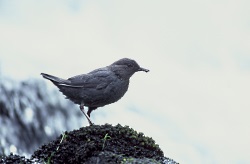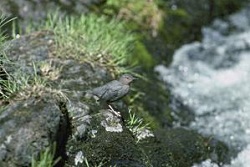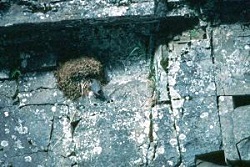
Courtesy: U.S. Fish & Wildlife Service
Dave Menke, Photographer
You are walking along side a swiftly-flowing mountain stream when you notice a slate-gray bird, tail cocked up jauntily like a wren’s, but a bird of a size nearer to that of a robin or large thrush. He is doing continual knee bends: bobbing up and down unceasingly. He (or is it she?) is perched on a rock drenched with spray from rapids. Your attention is arrested.
Suddenly the bird plunges into the foaming water as it rushes over rocks. Surely you will next see it (if at all) a bedraggled wreck surfacing way down stream, swept along to destruction by the raging torrent.

Courtesy: U.S. Fish & Wildlife Service
Dave Menke, Photographer
But no, he surfaces in a bit of calm water between rapids and swims nonchalantly to shore where he goes back to his bobbing routine, singing joyously all the while. What is this phenomenon you have stumbled upon?
You page through your field guide. Ah, here he is, the American dipper, also sometimes called a water ouzel. Yep, the bobbing is mentioned, along with the likelihood of his being found near rapidly flowing mountain streams in the American West. You also learn that he swims––no web feet but he swims––and better under water than on the surface, his wings assisting.
This bird was born almost literally of these waters. His parents built a mossy nest on a ledge of rock in the spray of the stream. His mother laid eggs looking like bubbles of foam. From one of these he emerged like Venus coming forth out of the sea.

Courtesy: U.S. Fish & Wildlife Service
He never strays far from these waters and seems impervious to the vicissitudes of weather––undaunted by snow and ice (after all his habitat flows too swiftly to freeze in the coldest weather), undeterred by heat (he has continual mist and frequent bathing to keep him cool).
So, the next time you are out––in summer’s heat or snowshoeing in coldest winter––keep an eye out for a nondescript little bird bobbing on a slippery or ice-coated rock beside a fast-moving mountain stream. You can report that you have sighted an American dipper.
This is Linda Kervin for Bridgerland Audubon Society.
Credits:
Photos: Courtesy U.S. Fish & Wildlife Service
https://digitalrepository.fws.gov/cdm4/item_viewer.php?CISOROOT=/natdiglib&CISOPTR=5349&CISOBOX=1&REC=5
Audio: Courtesy and Copyright 2008 Dr. Kevin Colver, Songbirds of Yellowstone, https://wildstore.wildsanctuary.com/
Text: Norman Davis, with thanks to Dorothy Egan, Bridgerland Audubon Society
Additional Reading:
The Water Ouzel from The Mountains of California as quoted in The Wilderness World of John Muir, https://www.amazon.com/Wilderness-World-John-Muir/dp/0618127518/ref=sr_1_1?
American Dipper-Cinclus mexicanus, Utah Division of Wildlife Resources, https://dwrcdc.nr.utah.gov/rsgis2/Search/Display.asp?FlNm=cincmexi
